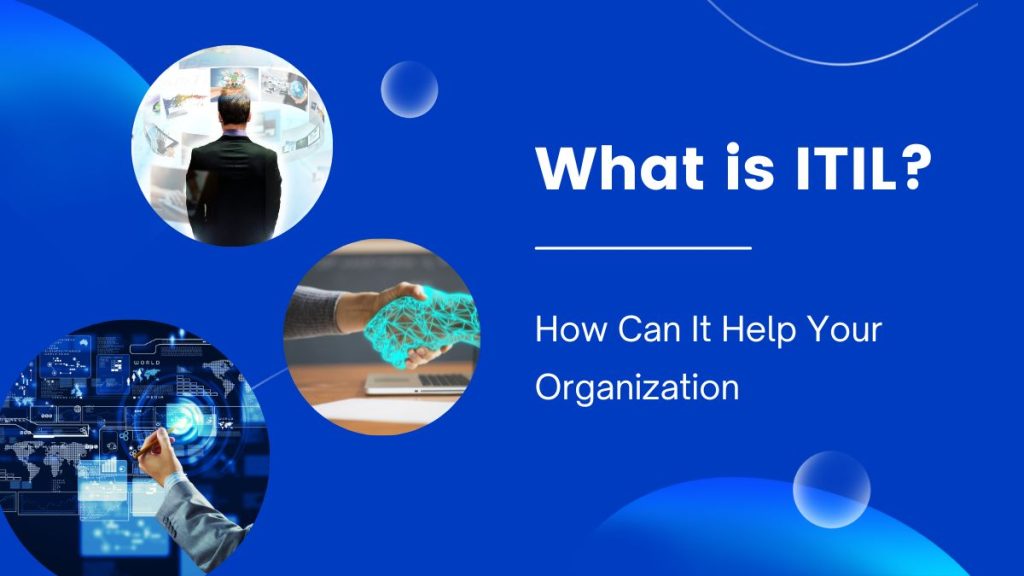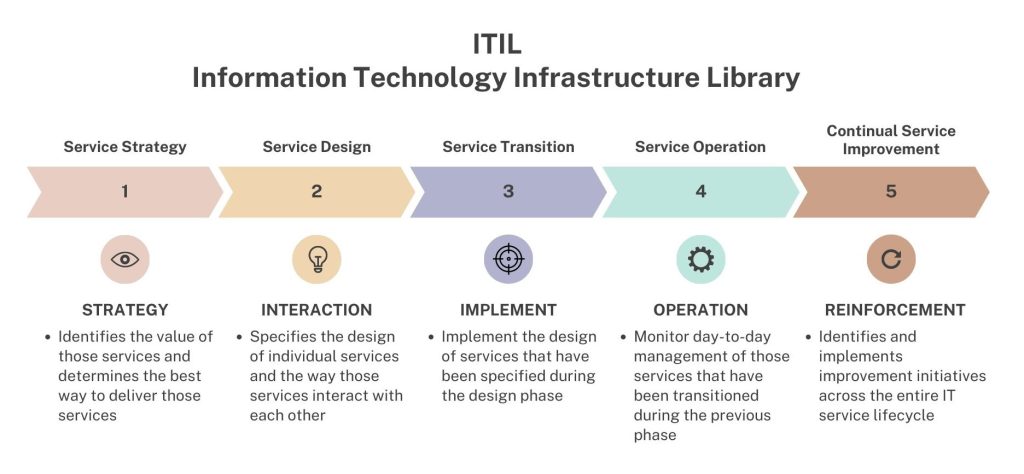What is ITIL and How Can It Help Your Organization

What Is ITIL (Information Technology Infrastructure Library)?
ITIL (Information Technology Infrastructure Library) is a set of best practices and principles for managing IT services and operations. It provides a comprehensive framework for organizations to better manage their IT service lifecycle, from planning and design to delivery and support.
With ITIL, organizations can also ensure compliance with industry standards and regulations. For the IT industry, it’s an invaluable tool for any organization looking to improve the performance of its IT services and operations. Let’s take a closer look at the components and advantages of ITIL.
Benefits of ITIL
ITIL enables organizations to better understand how their IT environment operates and helps them optimize it to maximize efficiency. As part of the digital transformation of a company, here are a few ways that organizations can benefit from ITIL:
Components of ITIL
ITIL is composed of five components: (1) service strategy, (2) service design, (3) service transition, (4) service operation, and (5) continual service improvement. Each component is associated with a set of concepts, terminologies, and activities. These components are interrelated and depend on each other to function effectively.
- Service strategy – The service strategy component defines the organization’s IT services, identifies the value of those services and determines the best way to deliver those services.
- Service design – The service design component specifies the design of individual services and the way those services interact with each other.
- Service transition – The focus of the service transition component is on implementing the design of services that have been specified during the design phase.
- Service operation – The service operation component is concerned with the day-to-day management of those services that have been transitioned during the previous phase.
- Continual service improvement – The continual service improvement component identifies and implements improvement initiatives across the entire IT service lifecycle.

How to Measure the Effectiveness of ITIL
Once an organization has fully implemented ITIL, it is important to continue using it to ensure that it remains effective. This is done by conducting regular assessments of the current state of the IT environment. By reviewing current processes, identifying any problems that exist, and recommending ways to solve them, organizations can ensure that they are gaining maximum value from the ITIL framework.
There are many ways to measure the effectiveness of an IT service. However, each one depends on the organization’s unique circumstances. Some ways to measure the effectiveness of an IT service include:
ITIL Certification
ITIL (Information Technology Infrastructure Library) certification is a widely recognized and highly sought-after credential that can have a positive impact on an individual’s career. The ITIL certification provides many benefits including
- Improved Job Security: ITIL certification helps demonstrate an individual’s commitment to their work and the IT industry, which can increase job security. Organizations will most likely hire, promote, or retain ITIL-certified professionals in the face of budget cuts and layoffs.
- Enhanced Career Opportunities: ITIL certification can open up more job opportunities and higher salaries. Employers are increasingly looking for IT professionals with ITIL certification as it shows a greater level of expertise and knowledge in the field.
- Increased Knowledge: ITIL certification provides an individual with the knowledge and understanding needed to manage technology infrastructure effectively, allowing them to develop their skills and become more effective in their job.
- Improved Performance: ITIL-certified individuals are better equipped to evaluate and improve their performance. By understanding ITIL processes, they can identify areas of improvement and establish best practices to achieve better results.
- Greater Efficiency: ITIL-certified individuals are able to use their knowledge and understanding of ITIL processes to work more efficiently, saving both time and money. This can help organizations improve their bottom line.
Overall, ITIL certification can be a valuable asset for any individual looking to advance their IT career. It provides numerous benefits, from improved job security and enhanced career opportunities to increased knowledge and improved performance.
Challenges of Implementing ITIL
One of the main challenges of implementing ITIL is the need for organizational change. It requires changes to organizational culture, structure, and processes. The process of implementing ITIL requires senior management buy-in and commitment to ensure successful implementation.
Another challenge of implementing ITIL is the complexity of the framework itself. It is a comprehensive set of processes and procedures that organizations must thoroughly understand to implement correctly. ITIL also requires a significant investment in terms of training, resources, and infrastructure.
It can also be difficult to measure the return on investment from ITIL implementation. As ITIL is a long-term process, it can be hard to determine the specific impact of ITIL implementation on the organization.
Finally, ITIL requires ongoing maintenance and review. It is important to regularly review ITIL processes and procedures to ensure they remain up-to-date and effective. This can be a time-consuming and costly process.
Conclusion
The implementation of ITIL is an organization-wide effort that involves all levels of the IT organization and extends to other business groups. By using ITIL, organizations can gain a better understanding of how their IT environment operates. Plus, they can learn how to optimize it and ensure they meet all service levels.
However, many organizations struggle to implement ITIL effectively. If an organization chooses to implement ITIL, it is important to choose an implementation partner that has extensive experience in this field and can help you to avoid common pitfalls.

Related Business
Business Intelligence 101: Master BI Technology
How To Advance Your Career in Tech
What Is Your Number? 7 Careers That Use Numbers
How to Become a Financial Analyst: The Basics
What is ITIL and How Can It Help Your Organization
What Does a Business Analyst Do?
What Is Digital Transformation and How It Can Help Your Business
How to Become a Business Intelligence Analyst